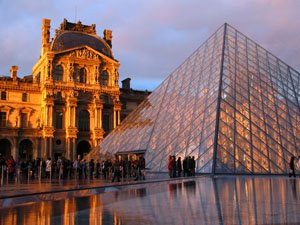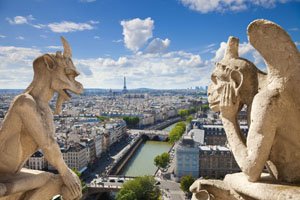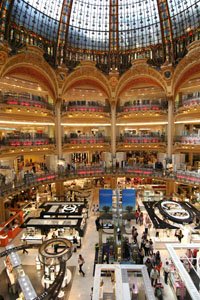Paris, City of many faces
 Paris: City of Light, beacon of romantics and capital of fashion and elegance. Yes, this beautiful city is all these things, but much more besides. More profound than the sum of its famous parts, such as the Eiffel Tower, Arc de Triomphe or Champs Elysées, Paris is a city of many layers, its history and present intertwined in a rich mosaic of beauty, grandeur, passion and sorrow. To truly discover Paris is as great an endeavour as to tame a wilderness or scale a giant peak.
Paris: City of Light, beacon of romantics and capital of fashion and elegance. Yes, this beautiful city is all these things, but much more besides. More profound than the sum of its famous parts, such as the Eiffel Tower, Arc de Triomphe or Champs Elysées, Paris is a city of many layers, its history and present intertwined in a rich mosaic of beauty, grandeur, passion and sorrow. To truly discover Paris is as great an endeavour as to tame a wilderness or scale a giant peak.
Like most great cities Paris is a place of clichés. Do the great monuments, sights and romantic aura of cinema, fiction and travel brochures hold true? Yes, Paris is not one of the world’s most popular tourist destinations for nothing; go out and marvel at the elegant buildings, walk the broad boulevards, visit the museums, soak in the café society and be seduced by those chic shops. This city has it all to offer; just don’t think you can come to grips with a place as big and fascinating as this in one visit. To unravel the many layers that truly make up Paris takes an understanding borne out of many years of experience – some even say a lifetime.
Monumental Paris
A first visit should include all the famous monuments and icons, why not? After all, who wouldn’t be excited to see the Eiffel Tower or stand before the Louvre for the first time? In a city with so much to see it is good to get your bearings, but looking at the map brings a poetry of names with it that sparks a sense of recollection: Rue de Rivoli, Place de la Concorde, Faubourg Saint Honoré, Place Pigalle…
 Fact is, you can see many of the most famous sights without ever having to stray too far from the Seine, lifeblood of the city since classical times, when it was a Gallo-Roman town called Lutetia. At the very heart of it all is the Ile de la Cité, the little island between the north and south banks that holds not only Notre Dame but also many of the city’s secrets deep within its bowels. For those interested in archaeology, this is the place to be, yet for most visitors it will be a whirlwind pilgrimage to the Louvre and adjacent Tuileries Gardens up to the Place de la Concord, along the Parc du Champs de Mars under the shadow of the Tour Eiffel, and up the broad Champs Elysées towards the rising outline of Napoleon’s Arch of Triumph – one of the most famous sights in the world.
Fact is, you can see many of the most famous sights without ever having to stray too far from the Seine, lifeblood of the city since classical times, when it was a Gallo-Roman town called Lutetia. At the very heart of it all is the Ile de la Cité, the little island between the north and south banks that holds not only Notre Dame but also many of the city’s secrets deep within its bowels. For those interested in archaeology, this is the place to be, yet for most visitors it will be a whirlwind pilgrimage to the Louvre and adjacent Tuileries Gardens up to the Place de la Concord, along the Parc du Champs de Mars under the shadow of the Tour Eiffel, and up the broad Champs Elysées towards the rising outline of Napoleon’s Arch of Triumph – one of the most famous sights in the world.
But there is more, much more. The Hôtel des Invalides, the Panthéon, the Jardins du Trocadero or the Saint-Sulpice church, made famous by The Da Vinci Code. Everywhere beautiful architecture reflecting a certain age and everywhere museums. In Paris, history lives on every corner, yet classicism and modernity stand side by side. Better preserved than most cities, with a centre still resplendent in Haussmann grandeur, there is an increasing mingling of old and new, with the Musée D’Orsay – a 19th century railway station that houses a museum – contrasting with Jean Nouvel’s ultramodern Musée du quai Branly or Richard Rogers and Renzo Piano’s now-famous Centre Pompidou. In fact, an entire glass and steel high-rise centre has joined the Paris skyline in recent decades. The modernist skyscrapers of La Défense may not be so different from those in a multitude of cities, but their impressive clustering to one side of the city – where it doesn’t detract from the classical beauty of Paris – is a poignant example of the French knack for planning and seeing the bigger picture. After all, this city is a masterpiece of urban planning and revival, the creation of Baron Haussmann lovingly nurtured and added to today.
Capital of chic
As if to underline this, the modern Arch of La Défense prolongs the perspective of Napoleon’s two triumphal arches, thus maintaining a tradition of symmetry and geometry that is at the heart of this city’s architectural harmony. Such elegant boulevards, some running along the original, pre-Greenwich zero meridian, are lined not only with museums and monuments, but also with elegant apartments, trendy cafés, stylish boutiques and the kind of fine dining venues that the French are famous for.
 In the capital of fashion, perfumery and cosmetics, great names such as Chanel, Dior and Boucheron have their own superstores, but equally impressive are grands magasins like the Galleries Lafayette, La Samaritaine or Printemps – each with its own magnificent rooftop restaurant. For a melange of décor, style and tradition, not to mention some of the finest cuisine anywhere, there is an entire listing of first class eateries that maintain the city’s position as the centre of gastronomic excellence. Combined with other refined pursuits, such as a visit to one of the many elegant art galleries, opera or theatre houses, this is the foundation upon which Paris’s reputation for chic is built.
In the capital of fashion, perfumery and cosmetics, great names such as Chanel, Dior and Boucheron have their own superstores, but equally impressive are grands magasins like the Galleries Lafayette, La Samaritaine or Printemps – each with its own magnificent rooftop restaurant. For a melange of décor, style and tradition, not to mention some of the finest cuisine anywhere, there is an entire listing of first class eateries that maintain the city’s position as the centre of gastronomic excellence. Combined with other refined pursuits, such as a visit to one of the many elegant art galleries, opera or theatre houses, this is the foundation upon which Paris’s reputation for chic is built.
Royal splendour and revolution
But the elegance of the Boulevard Saint Germain or Place de l’Opera is contrasted with many a grimy backstreet, plastered in graffiti. It was in Paris that Jean-Michel Basquiat gained acclaim as the first international artist of this genre, and in its suburbs that the art of free running first developed. The royal opulence of many a palace or imposing church is likewise juxtaposed with the spirit of rebellion that has lived here since 1789. Fiercely independent, Parisians have stormed the Bastille, raised barricades against advancing cavalry and even created a Paris Commune that lasted for several months before government troops finally broke through and the last communards were finished off within the walls of Père Lachaise cemetery.
This revolutionary and bohemian spirit lives on in Montmartre and in the seedy streets around Place Pigalle, now a red light district but once a colourful den of thieves. Think Moulins Rouge, the Can-Can and the coming together of intellectuals, artists, philosophers and romanticists such as Proust, Picasso, Hemingway and de Beauvoire in noisy, smoke-filled cafés. And here begins another facet of Paris; the more elusive human face of the city, which shows it as a place of romance, happiness, pain and longing. From bloody uprisings to wartime invasions, Paris has seen its share of misery, shedding plenty of blood but somehow emerging out of the smoke with most of its finest treasures intact.
It is once you become familiar with Paris’s landmarks, geography and above all, its story, that you begin to understand its people – a vital ingredient for really getting to know this most enticing of cities. Only then, when you know your way around the smaller, less known streets, know where the coffee is best, the cafés and restaurants, local markets and night scene most authentic, can you really say that you have experienced Paris. Discovering these delights, and mixing with local people in such colourful off-the-track areas such as Butte-aux-Cailles, is a process that is as rewarding as it is enlightening.










